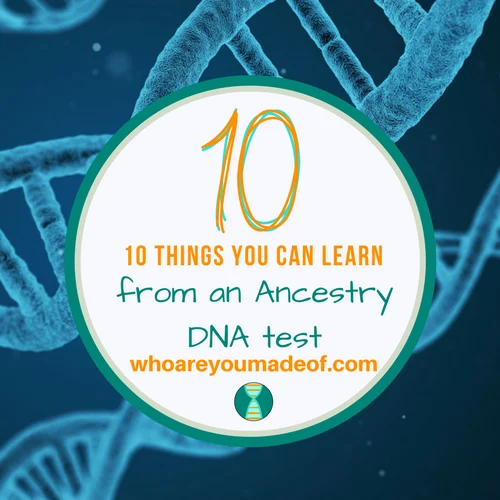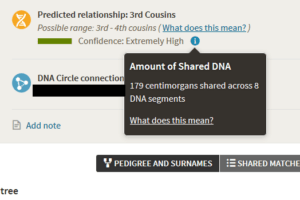If you are thinking about doing “one of those DNA tests”, and you’ve got some questions about it, you have come to the right place. In this post, I’ll explain what Ancestry DNA can tell you.
Your Ancestry DNA results will provide an incredible level of insight into your family’s past!
I did an Ancestry DNA test years ago, and it was very simple. My “kit” arrived a few days after I ordered it, and it just took a few minutes to fill the tube with saliva, seal the envelope, and slide it into the mailbox.

My results came about 5 weeks later. Sometimes it can take a little longer, and occasionally, lucky individuals can get theirs back a little more quickly.
Since then, my husband, both of my parents, my grandmother, several aunts, uncles, great uncles, cousins and siblings have all done the test to help me learn even more about our ancestors. In addition, their DNA testing helped me understand what kind of information you can learn from your Ancestry DNA test.
What will Ancestry DNA tell you?
Ancestry has the largest database for looking for family matches, however, so there is a huge advantage by testing with Ancestry. The best part about the whole thing is that once you do the test, you’ll keep getting new information about your DNA and your family history.
For example, your DNA stays in the database, so when more people test and show up as matches for you, you can log in to your test results and see more matches.
Additionally, Ancestry consistently works to improve their methods and does continual research into the way the results are presented and the information provided. So sometimes, you might log into learn something brand-new about your ethnicity. It’s really exciting – I just love it.
Your DNA Test Will Tell You Your Ethnicity
Using your DNA, Ancestry can determine the ethnicities that you inherited from each of your parents. Ancestry tests for dozens of ethnicities, and it does get fairly specific.
It’s important to know that you can’t inherit DNA that your parents didn’t have, and some DNA gets lost each generation. So if there are family rumors of a great-great-great-great grandfather who was Native American, it might not show up.
I will write more on this topic soon and include a link here.
On the topic of ethnicity estimates, you might like to read this post which goes into detail about what an ethnicity estimate really is: What is an ethnicity estimate?
Genetic Communities, Migrations, and Ancestry
Ancestry DNA can tell if you share genetic similarities to other groups of people around the world. For example, my grandmother’s DNA shows that she is genetically similar to the early settlers of Connecticut, Rhode Island, New York, and Michigan.
This matches perfectly what I know about her family tree.
My mother belongs to the Czech Republic, Poland, Slovakia and Lithuania genetic community, which is probably because she has tons of German, Slovak and Polish ancestry. German ancestry usually shows up as Germanic Europe DNA on Ancestry, but Germans might also have ancestors from other places in Europe that might match neighboring regions.
You can belong to multiple Genetic Communities, especially if you have ancestors from all over the United States and world.
Ideas About How You Might Be Related to Your Ancestry DNA Matches
The Ancestry DNA algorithm determines your possible relationship with your DNA matches based on the percentage of DNA that you share, and the number and size of the shared DNA segments.
It will place your matches into a general category. For example, my dad’s cousin is on my list of matches under the “2nd Cousin” heading.
He is a first cousin once-removed to me.
So, in order to figure out your exact relationship with your matches, you’ll have to use what you know about your family, plus what they know about their family, along with the suggested relationship from Ancestry’s test results.
To see a complete list of ways to figure out how you are connected with your DNA match, read this post:
Which leads to the next thing that you can learn from your Ancestry DNA test…
Centimorgans You Share With Your Family Matches
You can see exactly how many cMs (centimorgans) and how many segments of DNA you share with your DNA matches. I pasted an example below.
In the example, I share 179 cMs across 8 segments. This relationship could fall within a few different categories, but at least I have a good starting point.
Hint: the larger the segments, the closer the relationship!

If you want to learn more about how shared centimorgans can help you figure out how you might be related to your match, check out this post:
How Many DNA Matches You Have and How to Contact Them
Ancestry will tell you how many people who match your DNA at at a 4th cousin level or closer. You will be able to click on their names, contact them, learn about their ethnicities, see matches that you have in common with them, and possibly see their family tree.
In order to see how many DNA matches you have total (from the closest to the most distant), you can multiply the number of pages of matches that you have times 50. Some people many thousands of DNA matches – some less and some much more.
Whether You Share Common Ancestors With Other Test Takers
A really cool thing that you can learn, if you have attached a public tree to your test results, is the common ancestor that you share with some of your DNA matches.
If they have a public tree attached to their results, and so do you, Ancestry’s software will analyze the two trees looking for common names/dates. If they find one, it will appear on your DNA results page as a “Common Ancestor Hints“.
For me, this has been very helpful in family tree research. It helps me know when I am on the right track.
Matches That You Share in Common With Other Matches (Shared Matches)
Sometimes, people don’t know their family tree, or they haven’t made one. When this happens, it can be tough to figure out how they might be related to you. You can click on the “Shared Matches” tab and see the genetic relatives that you have in common.
Many times, some of these matches will have public family trees, and you can get some clues to your family and the way that you are related to these shared cousins.
A DNA Test Can Help You Find Lost Family
If you are looking for one or both of your biological parents or are looking for another biological relative, then doing this DNA test should be your first stop.
The great thing about this test is that when your results come back, if you do have a parent or a child who has already tested, it will tell you in no uncertain terms that you have a parent/child match.
If you don’t have the parent/child match, you can still use your results to find your parents, so it’s still extremely helpful in those searches.
Read more: How to find biological relatives using DNA
How To Tell Which Side of the Family Your DNA Matches are On
It’s great to have additional family take an autosomal DNA tests, if possible (this is just the scientific name for the Ancestry DNA test). If you are lucky enough to have a parent (or two) willing to do the test, too, you can sort your DNA matches by mother and father from your account.
This is very helpful in figuring out which side of the family your DNA matches are from.
Sometimes, shared matches can even help you figure out which line of the family a match is on. For example, is a 2nd cousin on your paternal grandfather’s side, or your maternal grandmother’s side?
Once you figure this out, you might be able to use the family tree of your Shared Matches to build your family tree out a little further, or even break past a brick wall. Amazing!
You Might Get AncestryDNA ThruLines
If you have enough DNA matches who have family trees, and if you have a tree that goes back a few generations on at least one line, you might some AncestryDNA ThruLines in your results. ThruLines can help you determine how you are related to your DNA matches, provide evidence that your family tree is correct, and and even help you find new ancestors.
Conclusion
I plan to write individual posts about each of these topics, to provide more in-depth information. If there are any questions that you have, or if there is a question you’d like me to write a post about, please contact me in the comments.
Thanks for stopping by 🙂
